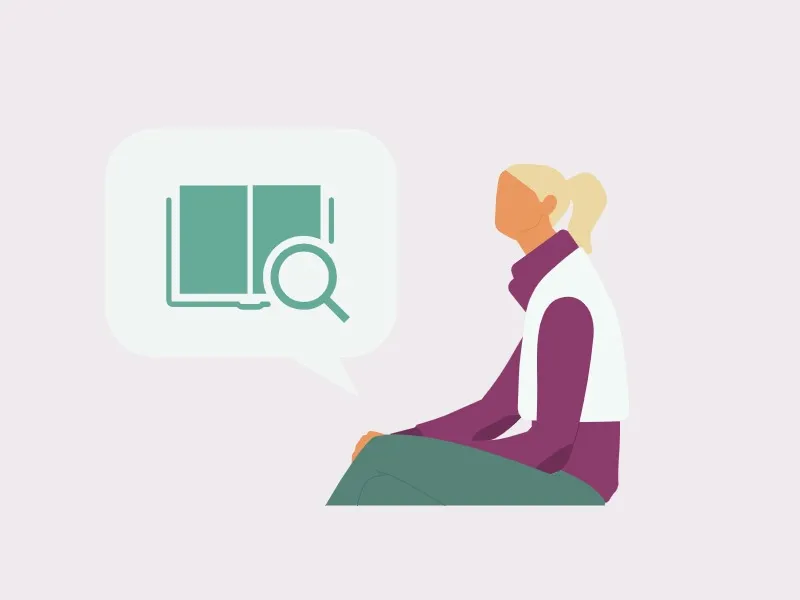What is purging disorder?
Individuals with purging disorder engage in repeated purging behaviors, such as:1
- Laxative misuse
- Self-induced vomiting
- Diuretics or other medication use
- Excessive exercise
Purging disorder does not involve binge eating. As such, the main component of this condition is purging behaviors.1 People with purging disorder engage in these eating disorder behaviors in an attempt to control their weight, size, or body shape.
Purging disorder falls under the category of Other Specified Feeding and Eating Disorders (OSFED) in the Diagnostic and Statistical Manual of Mental Disorders, Fifth Edition (DSM-5), which is the standard classification of mental health conditions used by mental health professionals throughout the U.S.1
How is purging disorder different than bulimia nervosa?
Both eating disorders involve self-induced vomiting as well as other types of purging, such as excessive exercise or laxative use. However, bulimia nervosa also involves binge eating episodes in which a person consumes a large quantity of food, often uncontrollably, in a short period of time. Unlike bulimia nervosa, purging disorder doesn’t include binge eating episodes.2
Moreover, purging is the main behavior and characteristic of purging disorder, whereas someone with bulimia nervosa may engage in other disordered eating behaviors, such as calorie restricting.2
Another difference is that because it is well understood by most professionals, bulimia nervosa has its own diagnosis in the DSM-5. Conversely, purging disorder, which is under-researched, falls under the broad category of “other specified feeding and eating disorder.” This category is reserved for eating disorders that don’t meet the diagnostic criteria for binge eating disorder, anorexia nervosa, and bulimia nervosa. There is a misconception that these additional eating disorders aren’t as severe as the three most common types, but that’s not true; purging disorder can be just as dangerous as bulimia nervosa and other eating disorders.1,2
Symptoms of purging disorder
As with other eating disorders, purging disorder is characterized by significant impairment in life functioning. Although there is no formal criterion for purging disorder, based on other eating disorders, other symptoms may include:1
- Recurring episodes of purging in an attempt to lose or control weight, such as:
- Compulsive exerciseMisusing laxatives
- Misusing diureticsUsing enemas
- Compensatory restriction
- Using other medications to attempt to lose weight - Preoccupation with weight and appearance
- Self-esteem that is heavily dependent on weight or appearance
- Profound fear of gaining weight
- Significant psychological and emotional distress
Contrary to popular belief, people of all sizes, shapes, and weights can struggle with eating disorders like purging disorder, which is why it’s so important to know the symptoms.
{{link-bank-two-column}}
Risk factors
Like other eating disorders and mental health conditions, purging disorder does not have a singular cause; instead, it is likely caused by many intersecting biological, psychological, and sociological influences known as risk factors. Risk factors increase a person’s likelihood of developing purging disorder, although they don’t necessarily mean someone is destined to develop this condition.
There is little known about the risk factors that are specific to purging disorder, but general eating disorder risk factors include:3,4
- Physical abuse
- Sexual abuse
- History of trauma or PTSD
- Obsessive compulsive traits or disorder
- Participating in weight-focused or appearance-based sports, such as wrestling, gymnastics, figure skating, or dance
- Perfectionism
- Dieting
- Family dieting
- Higher body weight in childhood
- Weight-based bullying
- Family history of eating disorders
- Stress
- Body dissatisfaction
- Low self-esteem
- Depression and anxiety
- Adopting cultural norms related to the “ideal” body
If you're seeking treatment for purging disorder, consider a remote program that you can complete 100% from home.
Learn more Harmful consequences of purging disorder
Purging disorder is a severe and dangerous eating disorder that can significantly harm a person’s physical and mental health. Dangerous effects of purging disorder may depend on a person’s specific purging behaviors (i.e., self-induced vomiting may have different effects compared to laxative misuse). However, potential risks include:5
- Oral bleeding
- Small bleeds in the eyes
- Tooth pain
- Gingival recession
- Dental lesions
- Tooth decay
- Parotid gland swelling
- Esophagitis
- Gastroesophageal reflux
- Heartburn
- Acid regurgitation
- Severe dehydration
- Irregular esophageal contractions
- Rectal prolapse
- Rectal bleeding
- Relaxed sphincter tone
- Irritable bowel syndrome
- Cardiovascular complications, such as congestive heart failure, heart attack, hypotension, and tachycardia
- Kidney inflammation
- Bowel dysfunction
- Seizures
- Rhabdomyolysis (dangerous breakdown of muscle tissue)
- Bloody stool
- Constipation
- Pancreas damage
Additionally, the mortality rate is much higher among people who have eating disorders. However, the specific rate for purging disorder is not currently known. This may be due to challenges surrounding identifying the cause of death using death certificates since families frequently list other causes.5 One study found that the mortality rate for Other Specified Feeding and Eating Disorders, which includes purging disorder as well as other eating disorders, is just over 5%.6
How to treat purging disorder
Because purging disorder hasn’t been well-studied, specific treatment has not been established for this condition. According to an eating disorder professional, most eating disorder treatment programs and modalities focus on treating binge eating and restriction, and there is a greater need for specific modalities that treat symptoms when binge eating is absent.1
However, many different therapies are used to treat eating disorders at large, some of which may be beneficial for people with purging disorders. These therapies may include:7
- Cognitive behavioral therapy (CBT): Patients learn the connection between their thoughts, feelings, and behaviors to reduce purging behaviors, prevent relapse, and modulate mood.
- Dialectical behavior therapy (DBT): Patients learn many skills to help reduce or eliminate purging behaviors, such as mindfulness, distress tolerance, emotional regulation, and interpersonal effectiveness.
- Exposure therapy: Patients are gradually exposed to fears in a safe, monitored environment. For people with purging disorder, this may involve an inability to engage in their preferred behaviors, such as not being allowed to exercise that day.
- Acceptance and commitment therapy (ACT): Patients are encouraged to accept various parts of their lives, even the negative emotions and experiences, as well as to change maladaptive behaviors, such as purging, and to act in line with their individual values.
Remote treatment for purging disorder
Some people may benefit from outpatient treatment for purging disorder, while others may need a higher level of care, such as partial hospitalization (day treatment), intensive outpatient (IOP), or inpatient or residential treatment.
Virtual treatment is also a beneficial option, especially for people who experience geographical barriers to care or have obligations that prevent them from attending in-person care.
Call for help You might be interested in









%2520%2520THUMB.webp)


